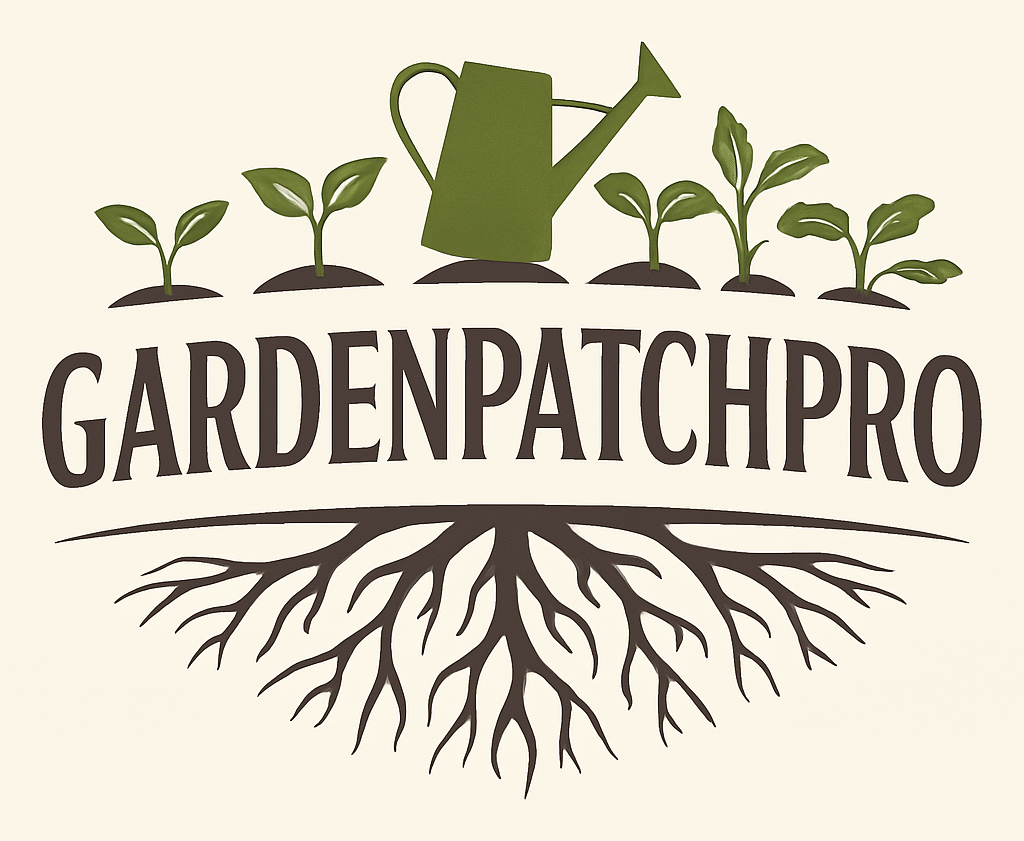16 Blue Flowers Essential for Stunning Garden Designs
Blue flowers are unique in gardens because true blue shades are rare in nature. They can bring calm and elegance to any outdoor space. Many people look for blue flowers to add a special touch to their gardens or homes.
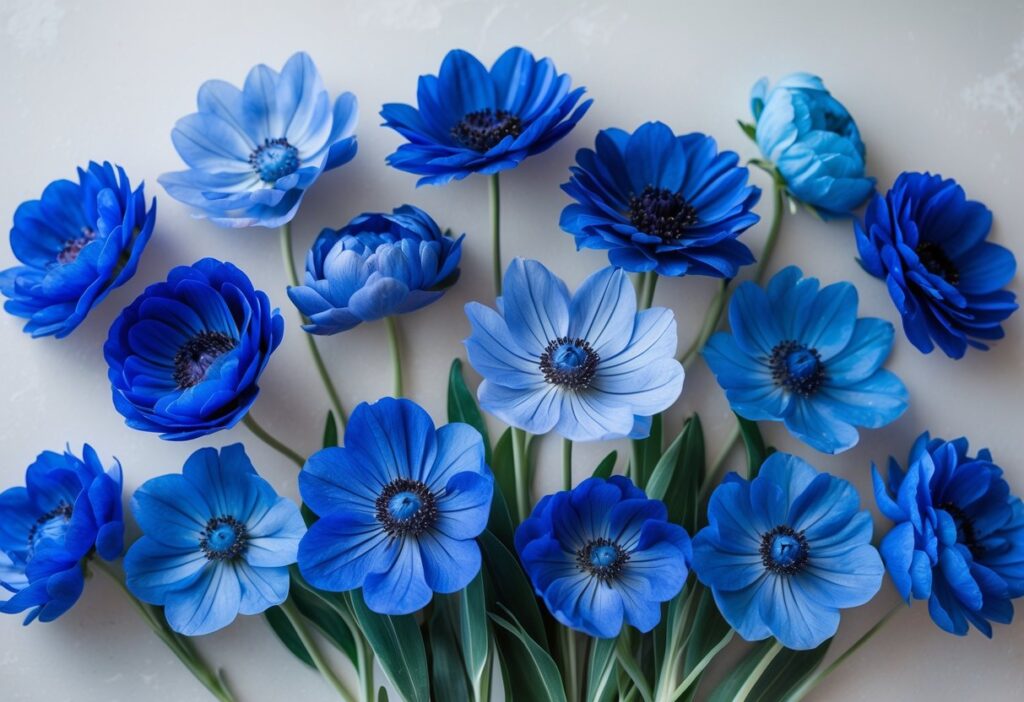
This article helps readers discover 16 different blue flowers, showcasing their variety and beauty. It offers a clear guide for those interested in planting or learning about these distinct flowers without confusion or exaggeration.
1) Blue Hydrangea
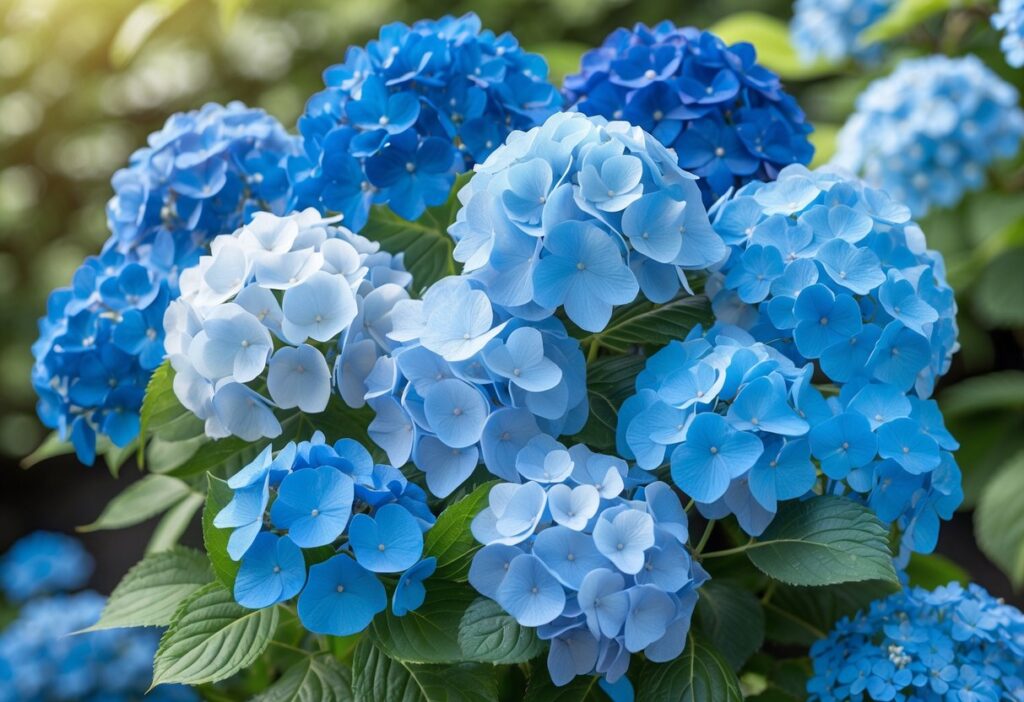
Blue hydrangeas are popular garden shrubs known for their large, round flower heads. They typically bloom in shades of blue, which depend on the soil’s acidity. More acidic soil results in bluer flowers.
One common type is the “Nikko Blue.” It grows about six feet tall and wide. This variety blooms large, rich blue flowers and is suited for part shade and moist soil.
Blue hydrangeas need regular watering and well-mulched ground to keep the roots cool and moist. They do well in garden borders, containers, or as stand-alone plants. With proper care, their blue color can be vibrant and long-lasting.
2) Cornflower (Centaurea cyanus)
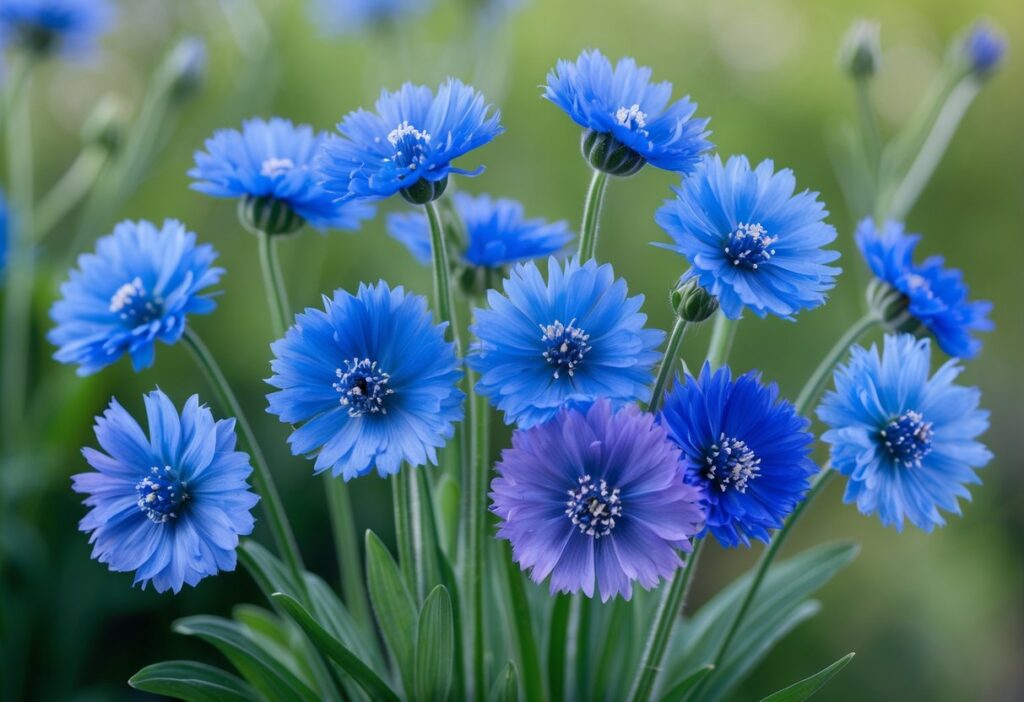
Cornflower, also called bachelor’s button, is an annual plant native to Europe. It often grows in fields and along roadsides. This plant usually reaches heights between 16 and 36 inches.
The flower is known for its bright blue color, though it can come in pink, white, lavender, or maroon. Its petals have a daisy-like shape with a slightly ragged edge. The blue tone can shift from deep to lighter shades as the flower blooms.
Cornflower is popular for gardens because it attracts pollinators like bees. It is easy to grow and requires low maintenance. The plant prefers cool seasons and can thrive in beds, borders, and flower mixtures.
The petals are also edible and sometimes used in salads or as decoration. Because of its color and appearance, cornflower is also used in fashion and other design projects.
3) Blue Iris
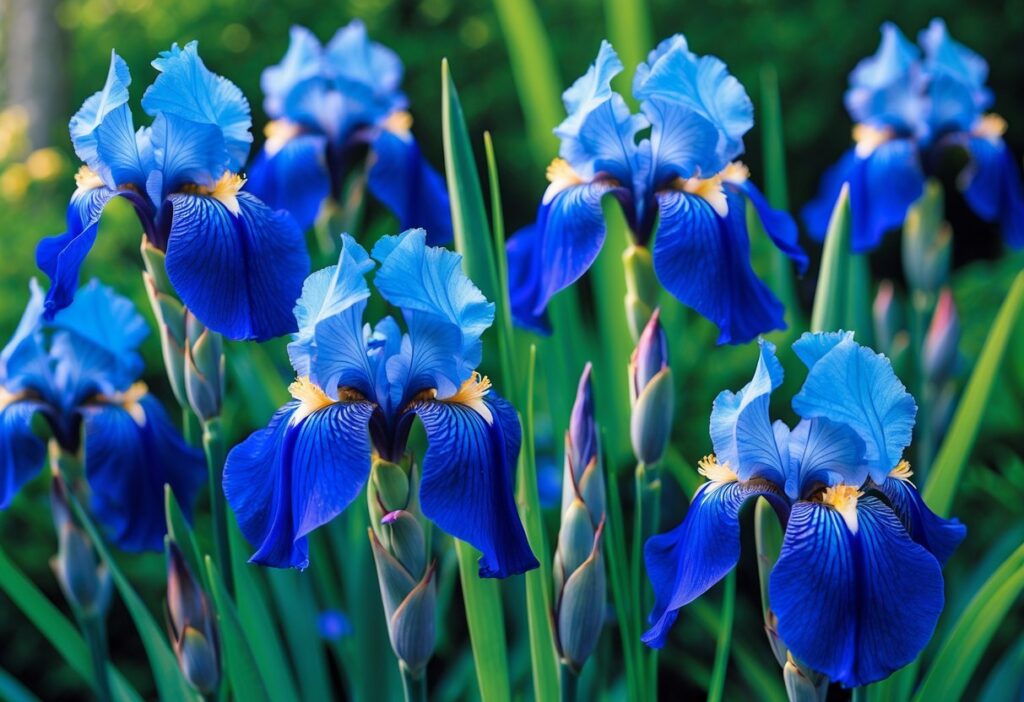
The Blue Iris is a well-known flower with striking blue-violet petals. It has sword-shaped leaves and produces large, elegant blooms. This flower often grows as a perennial and can reach heights of 3 to 5 feet.
Blue Iris flowers are common in spring. Their petals open fully to show bright yellow markings inside. These flowers are sometimes linked with feelings like hope and calmness.
Some types of Blue Iris, like the mini iris, are smaller and bloom early in the spring. They are hardy in many climates and can resist deer damage. Blue Iris plants need good care but are popular in gardens due to their unique color and shape.
True blue flowers are rare, but Blue Iris stands out as one with a deep blue shade. It is not only decorative but also easy to find as cut flowers or bulbs for planting.
4) Morning Glory
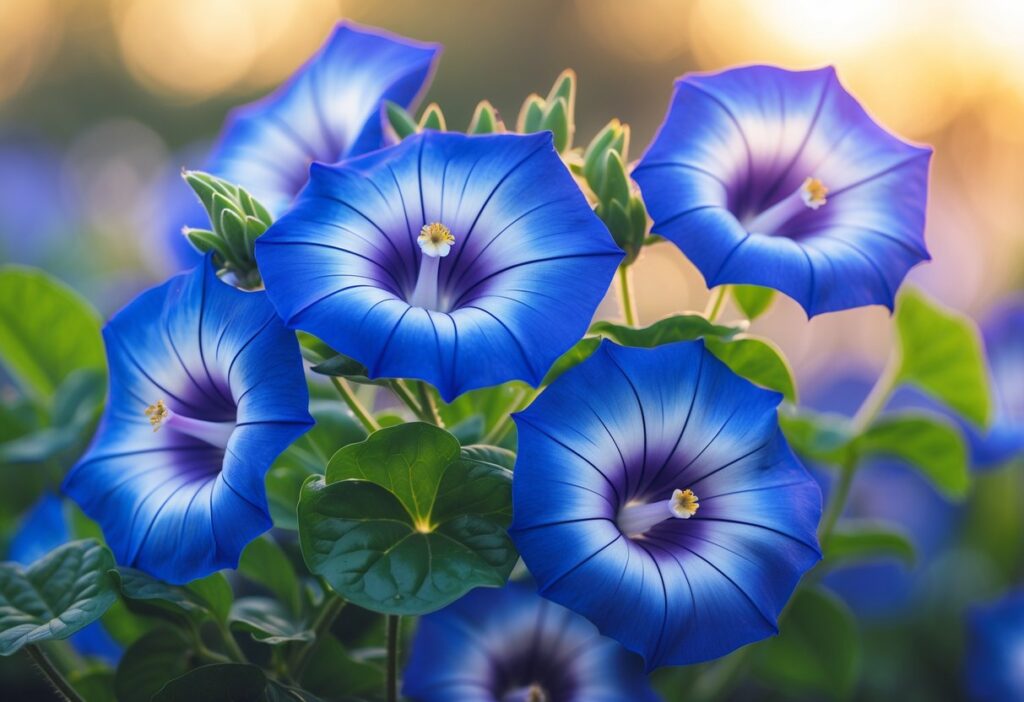
Morning Glory is a fast-growing vine known for its bright blue, trumpet-shaped flowers. The flowers open in the morning and close by afternoon, giving the plant its name.
One popular type is the “Heavenly Blue,” which features large, vivid blue flowers with white and yellow throats. It climbs fences, trellises, and arbors well.
Morning Glory flowers add classic charm to gardens with their vigorous growth. They prefer sunny spots and need support to climb as they can become heavy.
Another variety, the “Blue Star,” shows sky-blue flowers with a white star pattern in the center. The plant is strong and colorful, ideal for vertical garden spaces.
Some Morning Glory seeds can be toxic if ingested, but the plants themselves mainly offer visual appeal. They are a common choice for gardeners who want fast blooms and easy care.
5) Bluebell
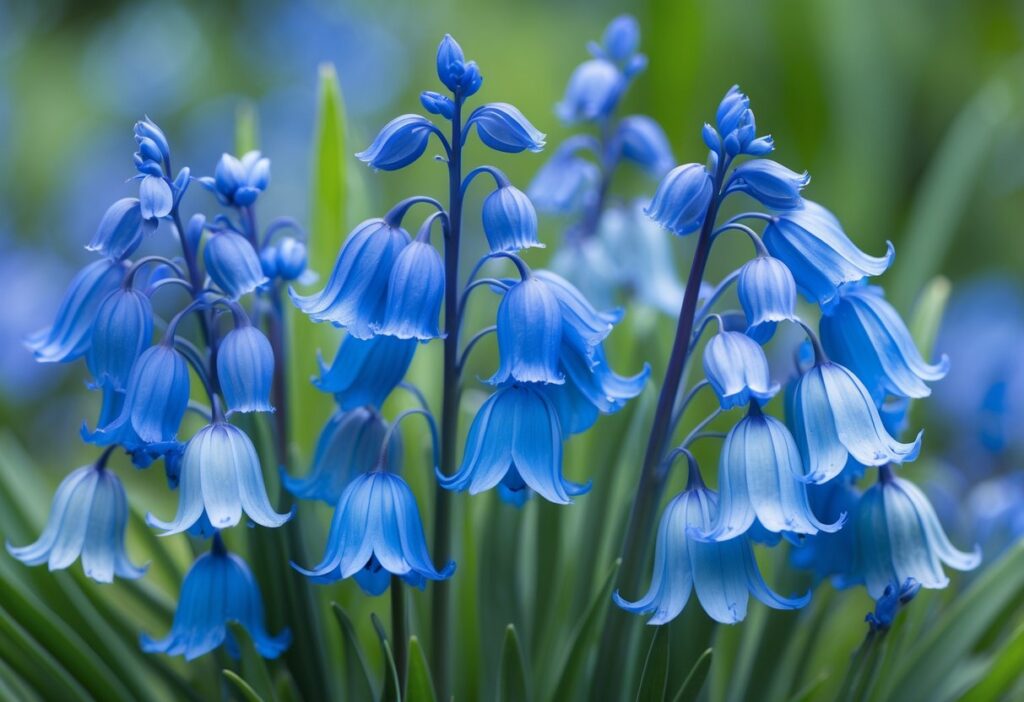
Bluebells are popular spring flowers known for their bell-shaped, blue to purple blooms. They often grow in clusters and create striking blue carpets in woodlands and gardens.
There are several types of bluebells, including the English bluebell and the Spanish bluebell. The English bluebell is smaller and has a sweet fragrance. The Spanish bluebell is taller and more robust, with larger flowers.
Bluebells prefer moist, shaded areas but can adapt to various soil types. They bloom in early spring, sometimes lasting into early summer. They are deer-resistant, making them a good choice for gardens.
These flowers are native to Europe but have closely related species in North America. Bluebell bellflowers, for example, grow in tougher, rocky soils and dry conditions.
Gardeners value bluebells for their beauty and ease of care. They are often used in borders or naturalized in lawns and woodlands to enhance spring landscapes.
6) Lobelia
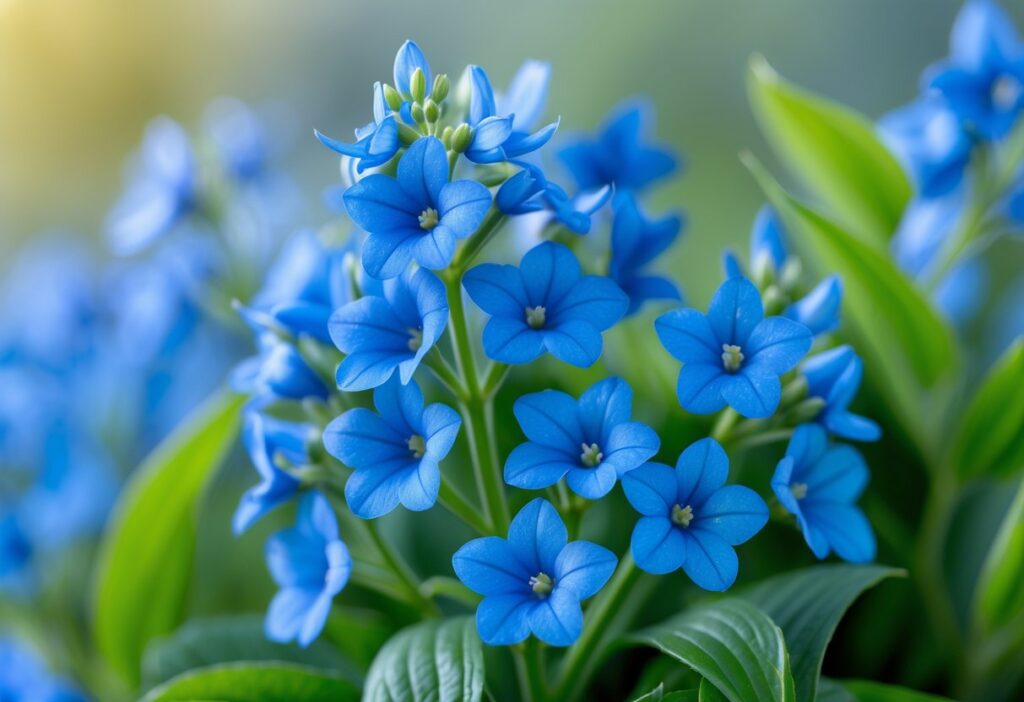
Lobelia is a group of plants known for their bright blue flowers. One common type is the Great Blue Lobelia, which grows 2 to 4 feet tall. It blooms in late summer and can last for about two months.
This plant prefers moist spots and partial sun. It often grows well near streams or ponds where the soil stays damp. Lobelia attracts hummingbirds, bees, and butterflies because of its nectar.
The flowers are tubular and have a unique shape with two lips. The lower lip has three lobes that stand out more than the upper two. Lobelia can form clumps and sometimes self-seeds in the right conditions.
It is easy to care for and usually has few problems with pests or diseases. Leaves are large and green, offering a nice backdrop to the bright blue flowers. It fits well into natural gardens and pollinator-friendly spaces.
7) Delphinium
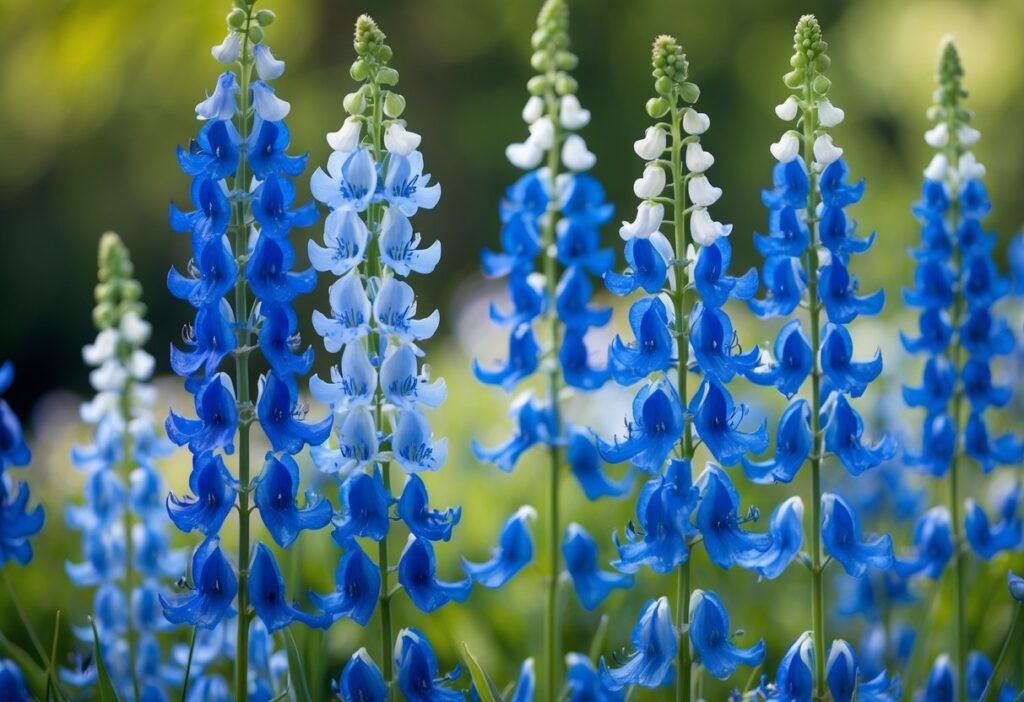
Delphiniums are tall, colorful flowers known for their striking blue spikes. They grow well in cool weather and prefer mild sunlight. Their blooms can range from deep indigo to light sky blue.
These plants are popular in gardens and flower arrangements because of their delicate, packed flowers. Some varieties, like ‘Diamonds Blue,’ produce bright cerulean blue blooms in their first year.
Delphiniums need moist soil and some care to prevent disease. They can be toxic if eaten, so gardeners should handle them carefully. Delphiniums work well in cottage gardens and as cut flowers.
8) Blue False Indigo
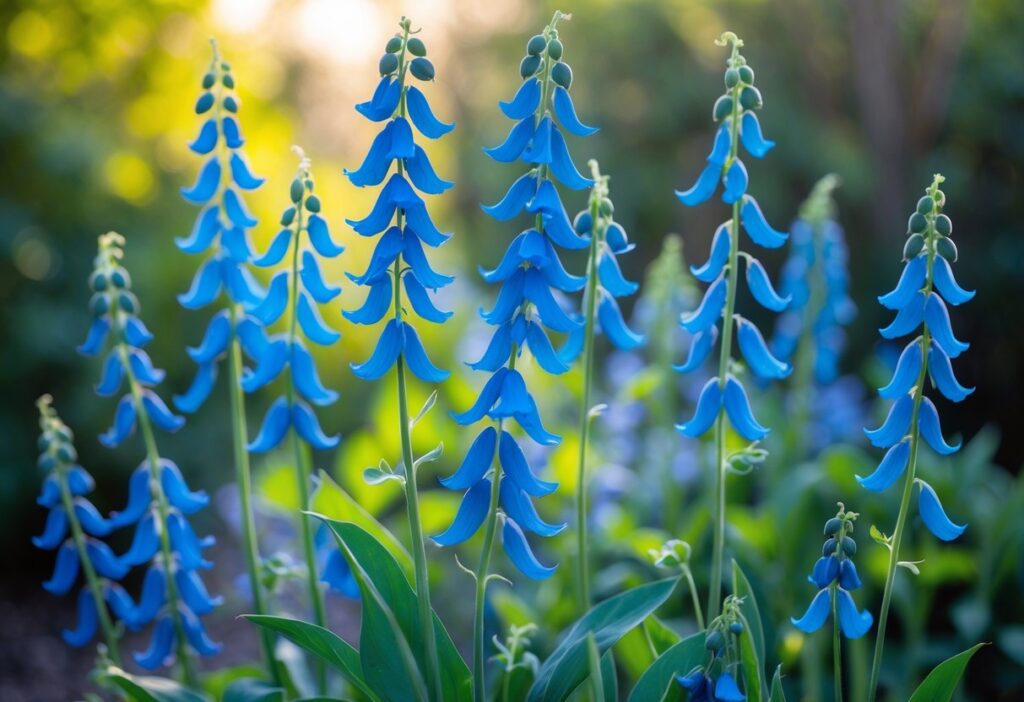
Blue False Indigo is a perennial plant that grows like a large bush. It features tall spikes covered in deep blue flowers. These flowers look similar to pea blossoms and bloom in late spring.
The plant usually reaches a height between 3 and 5 feet. Its leaves are divided into three leaflets and have a blue-green color. It prefers full sun but can tolerate some shade.
Blue False Indigo belongs to the bean family and produces black seed pods after flowering. It is a native plant in North America and is often used in gardens for its striking blue flower spikes. This plant is hardy and low-maintenance when planted in the right spot.
9) Bachelor’s Button
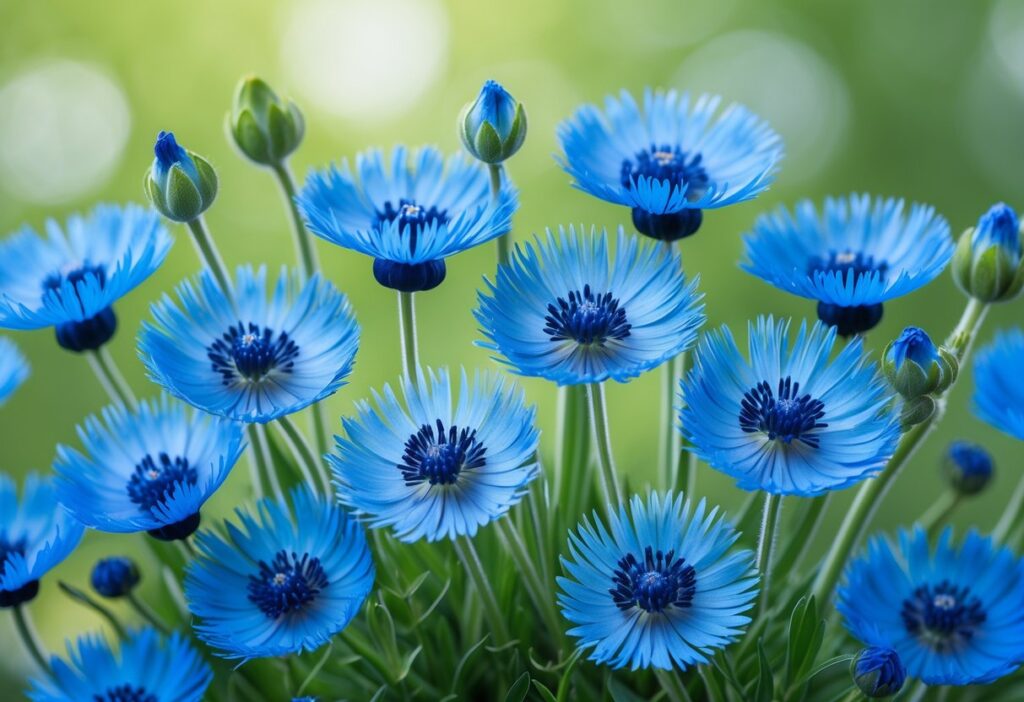
Bachelor’s Button, also known as cornflower, is a popular blue flower that typically grows between 12 to 30 inches tall. It produces bright, deep-blue blooms that work well in garden borders and flower beds.
This plant prefers full sun and well-drained soil. It is easy to grow from seed, usually sown directly outdoors in mid-spring when the soil is warm.
The flowers bloom in cool temperatures and attract pollinators like bees. They are often used fresh in bouquets or dried for decoration without losing their color.
Bachelor’s Button also has some uses beyond decoration. The petals can be added to teas or used as edible garnishes on foods like cakes.
Different varieties of Bachelor’s Button include dwarf types that grow knee-high and mixes with blue, purple, pink, and white flowers. This gives gardeners many color options for their landscapes.
10) Blue Salvia
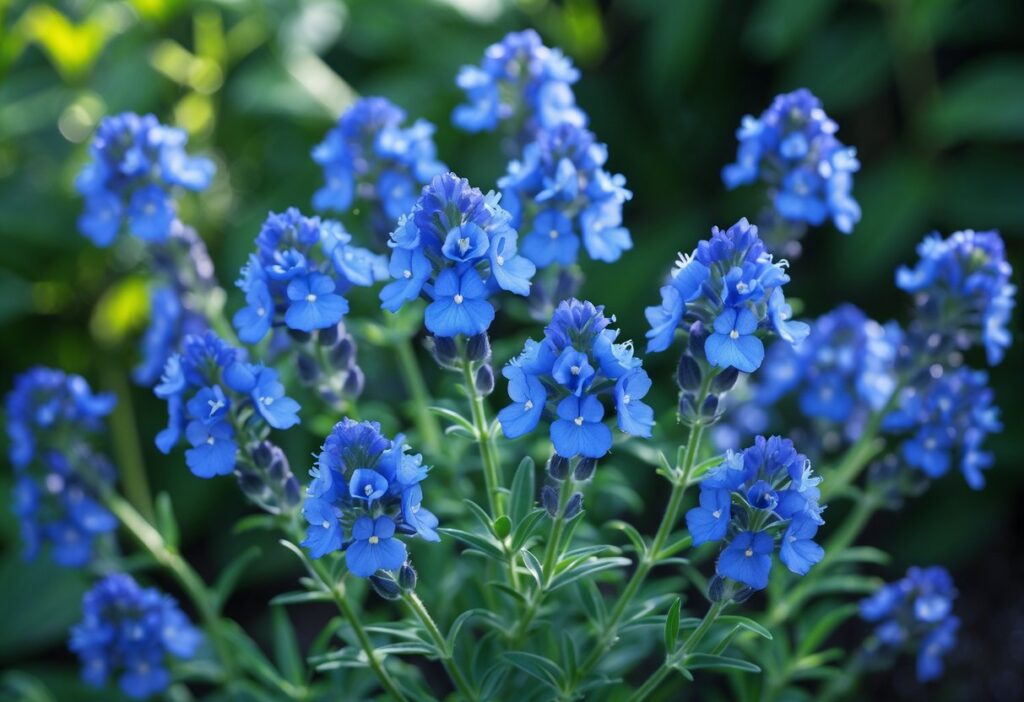
Blue Salvia is known for its striking spikes of blue flowers. It grows well in full sun to part shade. The plant usually reaches heights between 16 and 24 inches.
Its flowers bloom from late spring to early fall. The spikes can be 8 to 16 inches long, with deep blue or violet-blue colors. This makes it a popular choice for gardeners wanting long-lasting color.
Blue Salvia attracts pollinators like bees and hummingbirds. It is also fairly resistant to deer and rabbits. The plant prefers well-drained soil and regular watering but can tolerate some dryness once established.
There are several varieties, including ‘Victoria Blue’ and ‘Mystic Spires Blue’. These differ slightly in height and shade of blue, but all have dense flower spikes. Blue Salvia works well in garden beds, borders, or mixed containers for a splash of cool color.
11) Love-in-a-Mist (Nigella)
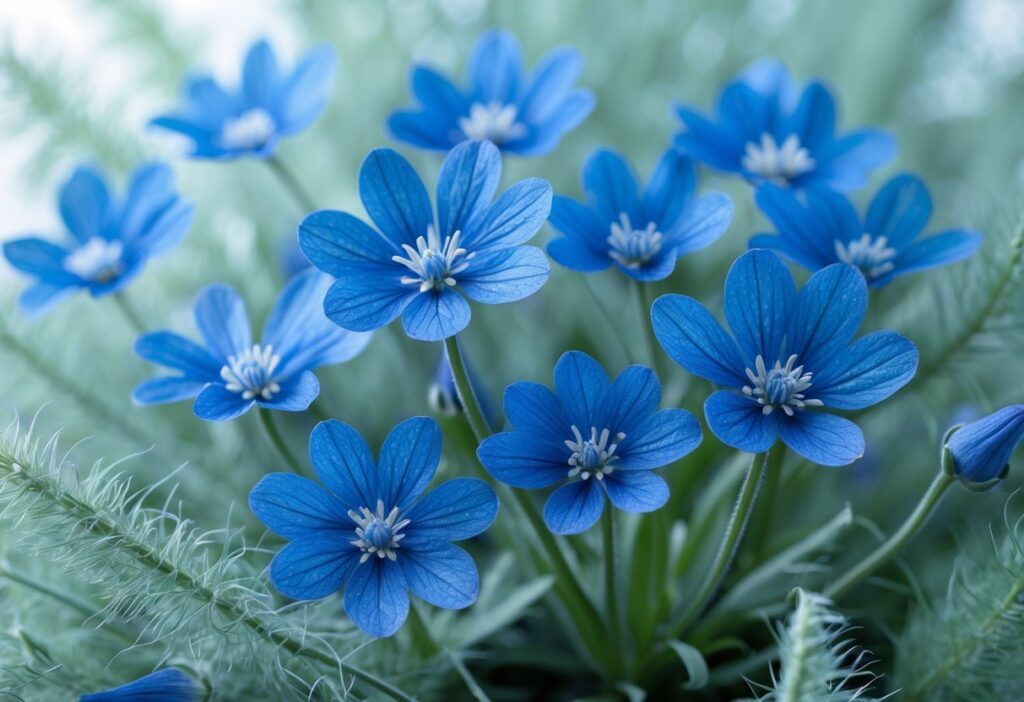
Love-in-a-Mist, or Nigella damascena, is a yearly flower known for its fine, feathery leaves that create a misty look around its blooms. The flowers come in shades of blue, pink, white, and purple. They grow on stems that reach about 1.5 to 2 feet tall.
This plant prefers cooler weather and grows well in garden beds or containers. It is easy to grow from seeds, which can be sown directly into the soil. Nigella is low-maintenance and does not need much care once established.
The flower blooms in summer, showing delicate, star-shaped petals. After blooming, it produces decorative seed pods. These pods are often used fresh or dried in floral arrangements. The plant can also self-seed, making it a sustainable choice for gardeners.
12) Gentiana
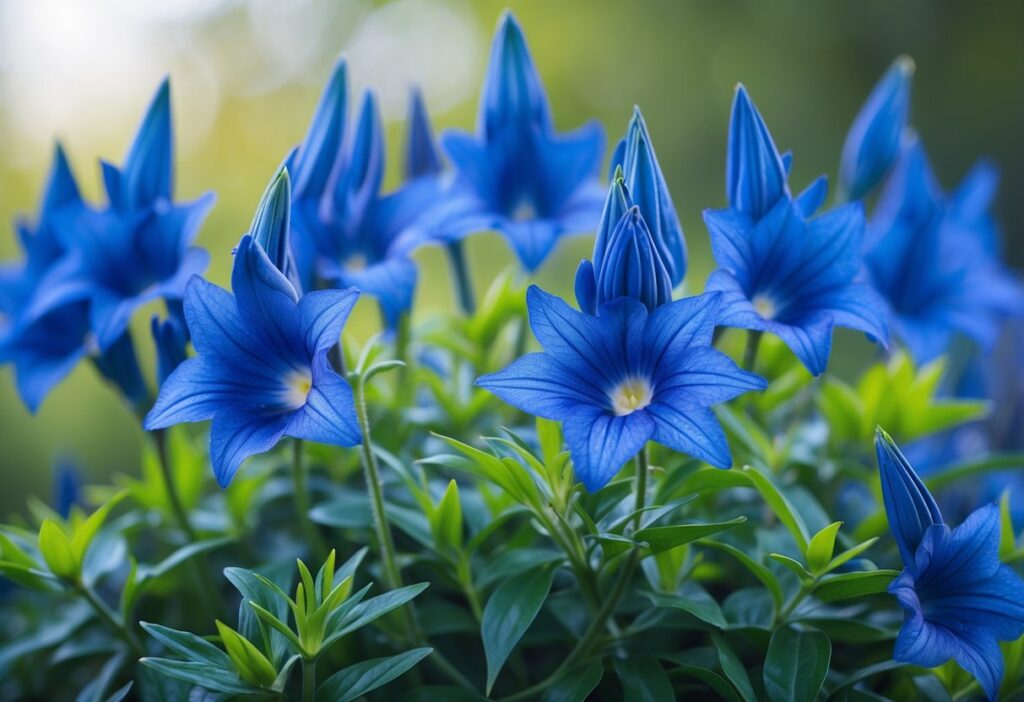
Gentiana is a large genus with over 300 species. It belongs to the Gentianaceae family and is known for its bright blue, trumpet-shaped flowers. The flowers often have a vivid, true blue color that stands out in gardens.
Many Gentiana species bloom from midsummer to early fall. The plant usually forms compact clumps with lance-shaped leaves. Some varieties, like Gentiana ‘True Blue’, produce tubular flowers along the entire stem, making for a long and striking bloom.
Gentiana prefers full sun to partial shade and well-drained soil. It is hardy in cooler zones, generally zones 4-7, and is often deer resistant. The plant does well in rock gardens and borders, especially varieties adapted to alpine conditions.
Some species like Gentiana acaulis bloom in spring and thrive in rocky, well-drained soil. Others, such as Gentiana septemfida, spread wider and serve well as ground cover. Hybrid types offer a range of bloom times and sizes for garden use.
13) Himalayan Blue Poppy
The Himalayan Blue Poppy, known scientifically as Meconopsis betonicifolia, is admired for its bright blue, cup-shaped flowers. It usually grows between 1 and 4 feet tall. The flowers have yellow centers and bloom in late spring to early summer.
This plant comes from the high mountain regions of the Himalayas. It prefers cool, shaded areas with moist, well-drained soil. It can be a bit tricky to grow because it needs specific conditions to thrive.
Despite being difficult to care for, newer hybrid varieties make it easier for gardeners to grow indoors or in temperate gardens. Its delicate blue flowers add a unique color that many other garden plants do not offer.
The Himalayan Blue Poppy is a perennial, meaning it returns each year. It blooms in succession, producing flowers over several weeks. It is best suited for gardeners willing to meet its needs for shade and moisture.
14) Blue Anemone
Blue Anemones are known for their bright, violet-blue petals with dark centers. They often bloom in early spring, making them a popular choice for gardens and containers.
These flowers grow from corms and prefer full sun to partial shade. They produce strong stems that hold large, dainty blooms, which can vary from single to semi-double petals.
Blue Anemones work well in borders or as cut flowers. They are deer-resistant and have lush green foliage that appears early in the spring. Some varieties have a charming, shy appearance in bud form before standing upright when fully open.
They thrive in mild climates and can be planted in fall or late winter. Their steady blooming and rich color make them a reliable choice for adding blue tones to flower arrangements or outdoor spaces.
15) Scabiosa (Pincushion Flower)
Scabiosa, commonly called pincushion flower, is known for its unique, round blooms that look like a pincushion. These flowers often come in shades of blue, lavender, and white. They are popular in gardens for their long-lasting blooms and delicate appearance.
The plant is a perennial, meaning it returns each year. It grows best in well-drained soil and prefers full sun to partial shade. It forms compact clumps with fine, fern-like foliage that adds texture to gardens.
Scabiosa flowers attract pollinators like butterflies and bees, making them great for wildlife gardens. Some varieties, like ‘Butterfly Blue,’ produce multiple flowers all season, creating a steady display of color.
This flower also works well as a cut flower for arrangements because the blooms last when cut. It fits nicely in borders, rock gardens, or mixed containers due to its neat habit and attractive flowers.
16) Blue Daisy (Felicia)
The Blue Daisy, also known as Felicia, is a small plant that grows between 8 to 18 inches tall. It produces bright blue, daisy-like flowers with yellow centers. These flowers bloom from summer into fall, creating a fresh and colorful display.
This plant prefers full sun and well-drained soil. It is tough in warm weather and does not need much water once it is established. The Blue Daisy is easy to grow and care for, making it popular for gardens and borders.
The plant attracts bees, butterflies, and birds, supporting local wildlife. It has compact, tidy foliage that stays neat without much pruning. Some varieties have variegated leaves, adding extra interest to the garden.
Blue Daisy plants are also known for not needing deadheading, which means old flowers do not always need to be removed to keep blooming. It is a low-maintenance choice for gardeners who want bright blue flowers with minimal effort.
Symbolism and Cultural Significance
Blue flowers carry deep meanings and have influenced various forms of creative expression. Their symbolism often includes emotions related to calmness and trust, while their presence in art and literature reflects cultural values and ideas.
Meanings Associated With Blue Flowers
Blue flowers commonly symbolize trust, loyalty, and serenity. Many cultures link them to calmness and peace, making them popular in gardens and floral gifts. Specific flowers like forget-me-nots express remembrance, while cornflowers stand for loyalty, and hydrangeas convey gratitude.
They also represent wisdom and spirituality in different traditions. Blue, as a color, reminds people of the sky and water, tying these flowers to ideas of openness and tranquility. This makes blue flowers suitable for many occasions, from expressing sympathy to celebrating meaningful relationships.
Blue Flowers in Art and Literature
Blue flowers have a strong presence in art and literary works, often symbolizing mystery or the unreachable. In Romantic literature, they represent longing and the search for deeper meaning. Artists have used blue flowers to evoke feelings of calm or to add mystique to their work.
In various cultures, blue flowers appear in myths and religious stories, giving them spiritual significance. Their rare and striking color makes them a symbol of beauty and rarity in many creative traditions, reinforcing their role as powerful visual and literary motifs.
Growing and Caring for Blue Flowers
Blue flowers need specific conditions to thrive, including the right soil and light levels. Gardeners should watch for common problems like pests and diseases and know how to fix them.
Soil and Sun Requirements
Most blue flowers prefer well-drained soil that is moderately fertile. Adding organic matter can improve soil texture and nutrient content. Some blue flowers, like the Blue Sky Vine, grow well in containers with good drainage.
Sun exposure depends on the species. Many blue flowers do best in full sun, about 6 hours daily. However, some, such as certain blue perennials, tolerate partial shade. Avoid planting blue flowers in heavy clay soils or spots that stay too wet, as this can cause root rot.
Common Challenges and Solutions
Blue flowers often face pests like aphids or slugs. Regular checks and natural pest controls, like neem oil, help keep these under control. Fungal diseases can also affect blue flowers, especially in damp conditions. Ensuring good air circulation and avoiding overhead watering can prevent these issues.
Some blue flowers might struggle to bloom if they don’t get enough sunlight. In these cases, moving them to sunnier spots promotes better flowering. Overwatering is another common problem; water only when the soil feels dry to the touch.
Frequently Asked Questions
Blue flowers vary in types, shades, and uses in gardens or bouquets. Some grow well in temperate climates while others need special care to keep their bright colors. Their meanings often relate to calmness, trust, and mystery.
What are the common types of blue flowers found in nature?
Common blue flowers include Blue Hydrangea, Cornflower (Centaurea cyanus), Blue Iris, Morning Glory, and Bluebell. These flowers are frequently seen in wild and garden settings.
Can you list blue flowers that are known for their unique hues?
Blue Hydrangea offers soft, pastel blues. Cornflower is notable for its intense, bright blue. Blue Iris typically has deep, rich blue petals. Morning Glory blooms show vibrant sky blue shades, while Bluebell has a delicate, gentle blue.
What are the meanings behind blue-colored flowers in floral arrangements?
Blue flowers often symbolize peace, serenity, and trust. They can also represent mystery or a sense of calm. Blue blooms are common in arrangements meant to bring comfort or express trustworthiness.
Which blue flowers are most suitable for a garden in temperate climates?
Flowers like Blue Hydrangea, Cornflower, and Bluebell thrive in temperate gardens. These plants handle cool to mild weather well and are fairly easy to grow with proper care.
Are there any rare or exotic blue flowers that are prized by gardeners?
While blue flowers are less common, some varieties such as unique Clematis or Lobelia cultivars are more rare and sought after. These can add distinctive colors and shapes to a garden.
What care instructions are typically recommended for maintaining the vibrancy of blue flowers?
Most blue flowers need well-drained soil and moderate watering. Avoid overwatering. They generally prefer full sun to part shade. Fertilizing during growth phases helps maintain healthy blooms and strong colors.
